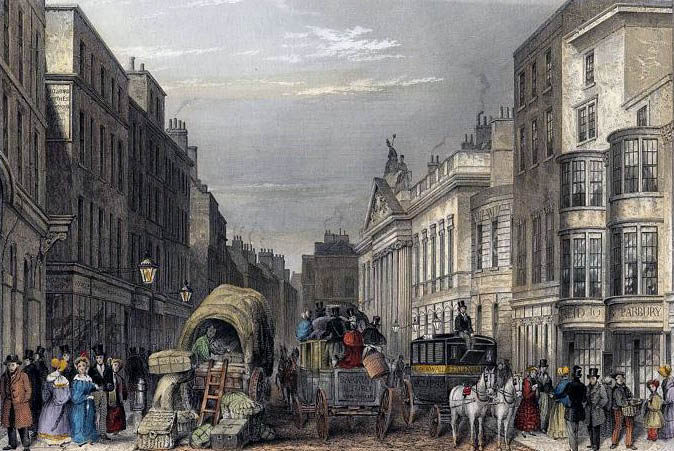By Judith Flanders
One of the earliest changes to the streets was the arrival of public transport. For most of the century, most people walked—an hour to work, an hour home, was not unusual. But in 1828, a coach-builder saw omnibuses on a visit to Paris, and he thought they might work in London.
Inside the buses held twelve seats, with another two seats beside the coachman. These box-seats were for favored regulars, who tipped the driver to ensure that places were kept for them. They were very much for men only. The driver offered the passenger the end of a leather strap. Grasping it with one hand, and a handle on the side of the bus with the other, the passenger put his foot on the wheel and then swung himself up. From 1849, there was also seating on top of the bus, reached by a set of iron rungs at the back which led to a bench, also the preserve of men: no woman in skirts could have managed the ladders. Inside was low-roofed, and so narrow that the knees of facing passengers touched. There was straw on the floor, to keep the damp and cold out, but it was not very effective, and usually very dirty.
Despite the discomfort, buses were soon indispensable—and an indispensable source of complaint. Initially, there were no tickets, and thus no check on the takings. Conductor and the driver therefore had a great incentive to stop for as many passengers as possible while admitting to the bare minimum. No conductor ever admitted his bus was full, swiftly thumping on the roof to signal the driver to move off once a passenger mounted, and drivers competed for fares, racing along the streets to get ahead of other buses to find passengers.
The noise these huge vehicles made was a contribution to the general din on the streets, which all visitors remarked on. One resident of a side-street noted the “everlasting sound of men, women, children, omnibuses, carriages, street coaches, waggons, carts, dog-carts, steeple bells, door bells.”

Leadenhall Street in Victorian London. Image is in the public domain, via Wikimedia Commons.
In part, the noise was because the streets were a place of work. Most suburban streets saw street-sellers come past at set times, days or seasons. First every morning came the sweeps, calling, “Sweep-o! Sw-e-e-e-p!,” followed by the dustman, ringing his bell and crying “Dust-ho!” as he arrived to collect the ashes that had been swept out of fireplaces.
They were followed by the milkmaids, carrying heavy wooden yokes over their shoulders, supporting milk-pails holding forty-eight quarts of milk. The yokes were sometimes painted with the name of the dairy, or carried the names of an aristocratic customer as advertising, such as “Wreathall, milkman to His Grace the Duke of Northumberland.” As they walked, the milkmaids called “Mi-o,” a contraction of “Milk, below” as they stopped at each house to hook a can onto a piece of string and lower it through the railings to the basement kitchens.
The next sellers were the watercress girls, then came the costermongers, selling fruit and vegetables, then the fishmongers’, the butchers’, and the bakers’ boys, or the cats’-meat man, selling horse meat on skewers for a farthing. Old-clothes men announced themselves by carrying a small clock under one arm, the striker of which they twanged as they walked along, calling, “Old clo’!” Many thought selling their clothes was shameful, so the old-clothes men prided themselves on discretion.
Other purchasers were stealthy because the sellers were disposing of goods they didn’t own. Dishonest servants sold the family’s food. Others saw various forms of recycling as their perquisites. In theory, households produced no food waste: it was reused in leftovers, then went to feed dogs, cats or chickens, or fertilize the garden. But many servants sold on these leftovers, called wash, to dealers who bought it for pig-food (hence “hogwash”).
Other street-sellers offered services, not goods. Tinkers with carts which held fire-pots for soldering called “Pots and Kettles to Mend!” “Chairs to mend” men repaired broken rush- or cane-bottomed seats. “Knives to Grind” men sharpened scissors and knives for housewives, cleavers at markets, and penknives for office workers in the days before steel-nibbed pens were common.
In commercial districts, food sellers predominated, virtually round the clock, from pre-dawn breakfasts at coffee-stalls to post-theater and post-drinking sandwiches and oysters-stands.
Hot eels were cheap and, because of their gelatinous consistency, filling, and so were a favorite of laborers, selling in halfpenny cupfuls, with a side dash of vinegar and pepper. Oysters were legendary as a poor-man’s food. In The Pickwick Papers, Sam Weller says sagely, “poverty and oysters always seem to go together.”
Beer was sold on the streets by potboys carrying wooden frames in which they slotted foaming cans, with a measuring jug hooked on the side. On weekday evenings these boys had set routes to supply residents with their supper beer, but householders could also call to a potboy as he passed.
Other items were seasonal. Cold weather was the time for warming items like pea-soup or pease-pudding. From August to April hot-potato men sold their wares from portable tin boxes with a fire at the bottom to keep the potatoes hot. One summer in the 1850s a girl was seen selling something that looked like “frozen soap-suds,” which may be an early sighting of ice-cream, which first appeared at this date, initially sold by Italian vendors, although later “Neapolitan” ice-cream was rumored to be frozen mashed turnip.
Year-round, a pie cost a penny, but all piemen were willing to toss a coin for one: if the customer won, he got a free pie; if the pieman won, the pieman kept pie and penny. Tossing for a pie was part of the language. Dickens used it regularly: in Pickwick Papers the stagecoach driver warns his passengers: “Take care o’ the archvay, gen’lm’n. ‘Heads,’ as the pieman says.”
JUDITH FLANDERS is an international bestselling author. Her book Inside the Victorian Home was shortlisted for the British Book Awards History Book of the Year. Flanders is a frequent contributor to the Daily Telegraph, Guardian, Spectator, and the Times Literary Supplement. Her latest book is The Victorian City.
